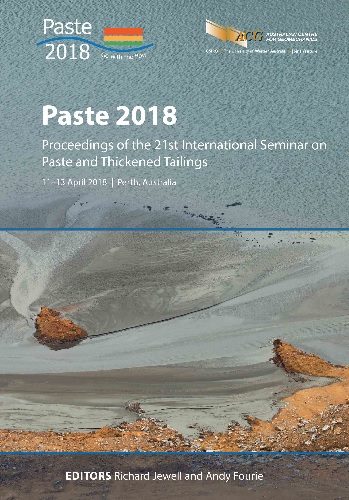Compressive strength behaviour of sulphur tailings paste backfill: effects of binders and additives

|
Authors: Wu, AX; Jiang, GZ; Wang, Y; Wang, YM; Wang, HJ; Li, C |
DOI https://doi.org/10.36487/ACG_rep/1805_44_Wang_Wu
Cite As:
Wu, AX, Jiang, GZ, Wang, Y, Wang, YM, Wang, HJ & Li, C 2018, 'Compressive strength behaviour of sulphur tailings paste backfill: effects of binders and additives', in RJ Jewell & AB Fourie (eds), Paste 2018: Proceedings of the 21st International Seminar on Paste and Thickened Tailings, Australian Centre for Geomechanics, Perth, pp. 507-514, https://doi.org/10.36487/ACG_rep/1805_44_Wang_Wu
Abstract:
Aimed at the common later strength failure phenomenon in sulphur tailings cemented paste backfill (CPB), this paper studies loss ratio (Li) of the unconfined compressive strengths (UCS) of CPB, and analyses the effect of binders and additives on the UCS behaviour of CPB samples in the laboratory. In testing, when the sulphur content of tailings was 6.1% and the main sulphide was pyrite, the L120 of samples using ordinary Portland cement (OPC) as a binder was 47.4%. The sulphate-resistant cement (SRC) increased the UCS of samples for seven days by 84.2%, but the UCS for 14 and 28 days decreased by 13.3 and 43.1%, respectively. Portland composite cement (PCC) can obviously deteriorate the UCS of the samples. As the sodium silicate increased the samples’ UCS for seven days, the L28 was also raised. Comparatively, a proper amount of citric acid can reduce Li, and after seven days UCS did not decrease when the dosage was 0.5%. The L56 of samples with the binder mixed by OPC and slag was 14.6%, then the UCS increased gradually, and while continuing to add 0.5% citric acid the UCS had no loss. These findings demonstrate that changing binder and adding moderate additive can avoid the UCS loss of sulphur tailings CPB.
Keywords: strength behaviour, sulphur tailings, binders, additives
References:
Ayora, C, Chinchon, S, Aguado, A & Guirad, F 1998, ‘Weathering of iron sulfides and concrete alteration: thermodynamic model and observation in dams from central Pyrenees, Spain’, Cement and Concrete Research, vol. 28, no. 4, pp. 591–603.
Bellmann, F, Möser, B & Stark, J 2006, ‘Influence of sulfate solution concentration on the formation of gypsum in sulfate resistance test specimen’, Cement and Concrete Research, vol. 36, no. 2, pp. 358–363.
Ercikdi, B, Kesimal, A, Cihangir, F, Deveci, H & Alp, I 2009, ‘Cemented paste backfill of sulphide-rich tailings: importance of binder type and dosage’, Cement and Concrete Composites, vol. 31, no. 4, pp. 268–274.
He, Z, Wang, L, Shao, YX & Cai, XH 2011, ‘Effect of decalcification on C-S-H gel microstructure in cement paste’, Journal of Building Materials, vol. 14, no. 3, pp. 293–298.
Kesimal, A, Yilmaz, E & Ercikdi, B 2004, ‘Evaluation of paste backfill mixtures consisting of sulphide-rich mill tailings and varying cement contents’, Cement and Concrete Research, 2004, vol. 34, no. 10, pp. 1817–1822.
Wang, HY, Zhang, AM & He, MK 2014, ‘Experimental study on unclassified tailing backfill materials proportion and pipeline transportation property with high sulphur and superfine particle’, China Mine Engineering, vol. 43, no. 6, pp. 1–4.
Wen, KW, Peng, L, Kang, RH & Wang, X 2016, ‘Experimental study on strength ratio of high sulphur superfine tailings filling material’, Mining Technology, no. 4, pp. 40–42.
Wu, AX & Wang, HJ 2015, Theory and Technology of Metal Ore Paste Filling, Science Press, Beijing, pp. 1–23.
Xiao, J, Deng, DH, Zhang, WN, Zeng, Z & Tang, XY 2006, ‘Formation of gypsum leading to the destruction of cement paste under the external sulphate attacking’, Journal of Building Materials, vol. 9, no. 1, pp. 19–23.
Yang, JS 2003, ‘Discussion on the action duality of ettringite and it's causing condition in concrete’, China Civil Engineering Journal, 2003, vol. 36, no. 2, pp. 100–103.
© Copyright 2025, Australian Centre for Geomechanics (ACG), The University of Western Australia. All rights reserved.
View copyright/legal information
Please direct any queries or error reports to repository-acg@uwa.edu.au
View copyright/legal information
Please direct any queries or error reports to repository-acg@uwa.edu.au



